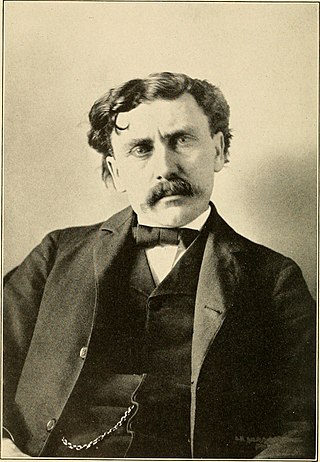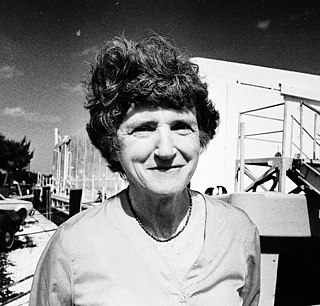
The Smithsonian Institution, or simply the Smithsonian, is a group of museums, education and research centers, the largest such complex in the world, created by the U.S. government "for the increase and diffusion of knowledge." Founded on August 10, 1846, it operates as a trust instrumentality and is not formally a part of any of the three branches of the federal government. The institution is named after its founding donor, British scientist James Smithson. It was originally organized as the United States National Museum, but that name ceased to exist administratively in 1967.

James Mooney was an American ethnographer who lived for several years among the Cherokee. Known as "The Indian Man", he conducted major studies of Southeastern Indians, as well as of tribes on the Great Plains. He did ethnographic studies of the Ghost Dance, a spiritual movement among various Native American culture groups, after Sitting Bull's death in 1890. His works on the Cherokee include The Sacred Formulas of the Cherokees (1891), and Myths of the Cherokee (1900). All were published by the US Bureau of American Ethnology, within the Smithsonian Institution.

The National Museum of Natural History (NMNH) is a natural history museum administered by the Smithsonian Institution, located on the National Mall in Washington, D.C., United States. It has free admission and is open 364 days a year. With 4.4 million visitors in 2023, it was the second most-visited museum in the United States.

The Bureau of American Ethnology was established in 1879 by an act of Congress for the purpose of transferring archives, records and materials relating to the Indians of North America from the Interior Department to the Smithsonian Institution. But from the start, the bureau's visionary founding director, John Wesley Powell, promoted a broader mission: "to organize anthropologic research in America." Under Powell, the bureau organized research-intensive multi-year projects; sponsored ethnographic, archaeological and linguistic field research; initiated publications series ; and promoted the fledgling discipline of anthropology. It prepared exhibits for expositions and collected anthropological artifacts for the Smithsonian United States National Museum. In addition, the BAE was the official repository of documents concerning American Indians collected by the various US geological surveys, especially the Geographical and Geological Survey of the Rocky Mountain Region and the Geological Survey of the Territories. It developed a manuscript repository, library and illustrations section that included photographic work and the collection of photographs.

John Peabody Harrington was an American linguist and ethnologist and a specialist in the indigenous peoples of California. Harrington is noted for the massive volume of his documentary output, most of which remains unpublished: the shelf space in the National Anthropological Archives dedicated to his work spans nearly 700 feet.
The Human Studies Film Archives (HSFA) is a sister archive to the National Anthropological Archives within the Smithsonian's National Museum of Natural History. HSFA preserves and provides access to ethnographic films and anthropological moving image materials. It is located at the Smithsonian Museum Support Center in Suitland, Maryland.

The Tuxtla Statuette is a small 6.3 inch (16 cm) rounded greenstone figurine, carved to resemble a squat, bullet-shaped human with a duck-like bill and wings. Most researchers believe the statuette represents a shaman wearing a bird mask and bird cloak. It is incised with 75 glyphs of the Epi-Olmec or Isthmian script, one of the few extant examples of this very early Mesoamerican writing system.
Jason Baird Jackson is an American anthropologist who is Professor of Folklore and Anthropology at Indiana University Bloomington. He is "an advocate of open access issues and works for scholarly communications and scholarly publishing projects." At IUB, he has served as Chair of the Department of Folklore and Ethnomusicology and as Director of the Folklore Institute. According to the Journal of American Folklore, "Jason Baird Jackson establishes himself as one of the foremost scholars in American Indian studies today."

Museum anthropology is a domain of scholarship and professional practice in the discipline of anthropology.
The Smithsonian Marine Station at Fort Pierce is a research center that specializes in Floridian marine ecosystems and lifeforms. The research is focused mostly on the Indian River Lagoon and also on the offshore waters of Florida's central and east coast. The first director of the station was Mary Rice, who was also instrumental in its founding.
Michael Atwood Mason is an American folklorist and museum professional. He was CEO and Executive Director of President Lincoln's Cottage. Up to February 2021 he was the Director of the Smithsonian Center for Folklife and Cultural Heritage.
Candace S. Greene is a museum anthropologist on the staff of the Department of Anthropology, National Museum of Natural History, Smithsonian Institution.
Osteoware is a free data recording software for human skeletal material that is managed through the Smithsonian Museum of Natural History. It is used by biological anthropologists to document data relevant to research and forensic applications of human skeletal remains in a standardized and consistent way. It has influenced other skeletal recording software, and has been successfully used at the Smithsonian for collecting data relevant to biological anthropology. Osteoware is the only free, individual-use software for the collection of data on skeletal material in anthropology.
Conservation and restoration at the Smithsonian Institution deals with the care of the 138 million artifacts located in the collections of Smithsonian Institution. Work is conducted by one research center, the Museum Conservation Institute (MCI), and by conservators at the Smithsonian's museums, galleries, zoo. Smithsonian conservators provide myriad services to their units, including exhibit preparation of the museum collection and loan objects, advising on object care, training for future generations of conservationists, engaging in routine preventive care on a daily basis, conducting research projects related to the collections, and examining objects for evidence of manufacturing techniques and previous restorations All conservation labs collectively further the mission of the Smithsonian Institution, "the increase and diffusion of knowledge." Founded in 1846 the Smithsonian is the world's largest museum and research complex, consisting of 19 museums and galleries, the National Zoological Park, and nine research facilities.
Conrad Maynadier Arensberg was an American anthropologist and scholar.

Mary Esther Rice was an American invertebrate zoologist specializing in systematics, evolution and the development of marine invertebrates. She worked at the Smithsonian Institution as a curator, educator, research advisor, and administrator from 1966 until her retirement in 2002. She is known for her work on the life histories of Sipuncula, as well as for serving as the first director of the Smithsonian Marine Station at Fort Pierce.
Donald Ray Davis is an American entomologist, specializing in Lepidoptera.
Lucile Eleanor St. Hoyme was an American biological anthropologist who conducted research related to human variation, bioarcheology, and paleopathology. St. Hoyme served as an Assistant Curator in the Department of Anthropology at the National Museum of Natural History. St. Hoyme analyzed human remains excavated from the John Kerr Reservoir Basin using a new bioarcheological approach combining data from other disciplines. Beyond her work with the Smithsonian collections, St. Hoyme also worked on FBI forensic cases in the 1960s with National Museum of Natural History Anthropology Curator J. Lawrence Angel.
Dache McClain Reeves (1894-1972) was an aerial photographer who helped advance aerial archaeology within the United States. In 1918, for his actions in World War I, he was awarded the Distinguished Service Cross and the Silver Star while serving as a First Lieutenant with the 9th Aero Squadron, U.S. Army Air Service.
Jeffery T. Williams is an American ichthyologist. He is primarily interested in the systematics, taxonomy, and zoogeography of marine fishes. He is the retired Collections Manager in the Division of Fishes at the National Museum of Natural History of the Smithsonian Institution.








